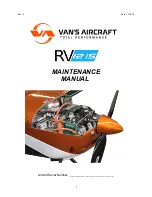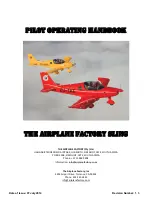
10
reaches the stabilizer that is trapped between the other lines. This line has
a different color and belongs to the external lines of the Criser.
Pull on this line until it is tense, this should help to undo the wing tangle.
If you cannot undo the tangle, fly to the nearest possible landing spot,
control the flying course with your body movements and a little pressure
on the opposite brake. Be careful when attempting to undo a tangle if you
are flying near a mountainside or near to other paragliders, you may lose
control of the flying course and a collision may occur.
Over handling
Most flying incidents are caused by incorrect actions of the pilot, which
chained one after another creates abnormal flying configurations (a
cascade of incidents). You must remember that over handling the wing will
lead to critical levels of functioning. The IKUMA is designed always to try
to recover normal flight by itself, do not try to over handle it.
Generally speaking, the reactions of the wing, which follow over handling,
are neither due to the input made or the intensity, but the length of time the
pilot continues to over handle. You have to allow the profile to re-establish
normal flight speed after any type of handling.
4.3 USING THE ACCELERATOR
The profile of the IKUMA has been designed to fly stable through its
entire speed range. It is useful to accelerate when flying in strong winds
or in extreme descending air. When you accelerate the wing, the profile
becomes more sensitive to possible turbulence and closer to a possible
frontal collapse. If you feel a pressure loss, you should release the pressure
on the accelerator and pull slightly on the brake lines to increase the angle
of incidence. Remember that you have to re-establish the flight speed after
correcting the incidence.
It is NOT recommended to accelerate near to the mountainside or in very
turbulent conditions. If necessary you will have to constantly adjust the
movements and pressure on the accelerator whilst constantly adjusting
the pressure applied to the brake lines. This balance is considered to be
“active piloting.”
The IKUMA risers have been designed without any adjustable, removable
or variable device to prevent and incorrect use of the accelerator system.
4.4 FLYING WITHOUT BRAKE LINES
If, for any reason at all, you cannot use the brake lines of your IKUMA
you will have to pilot the wing using the C-risers and your body weight
to fly towards the nearest landing. The C-lines steer easily because
they are not under pressure, however you have to be careful not to over
handle them causing a stall or negative turn. To land you have to let the
wing fly at full speed and before reaching the ground you will have to
pull symmetrically on both the C-risers. This braking method is not as
effective as using the brake lines so you will land at a higher speed.
4.5 KNOTS IN FLIGHT
The best way to avoid these knots and tangles is to inspect the lines
before you inflate the wing for take-off. If you notice a knot before take-
off, immediately stop running and do not take-off.
If you have taken-off with a knot you will have to correct the drift by
leaning on the opposite side of the knot and apply the brake line on that
side too. You can gently try to pull on the brake line to see if the knot
becomes unfastened or try to identify the line with the knot in it. Try to
pull the identified line to see if the knot undoes. Be very careful when
trying to remove a knot. When there are knots in the lines or when they
are tangled, do not pull too hard on the brake lines because there is an
increased risk of the wing to stalling or negative turn being initiated.
Before trying to remove a knot, make sure there are no pilots flying nearby
and never try these maneuvers near the mountainside. If the knot is too tight
and you cannot remove it, carefully and safely fly to the nearest landing place.
Summary of Contents for IKUMA 21
Page 1: ...USER S MANUAL IKUMA...
Page 17: ...10 3 RISERS ARRANGEMENT 17...










































